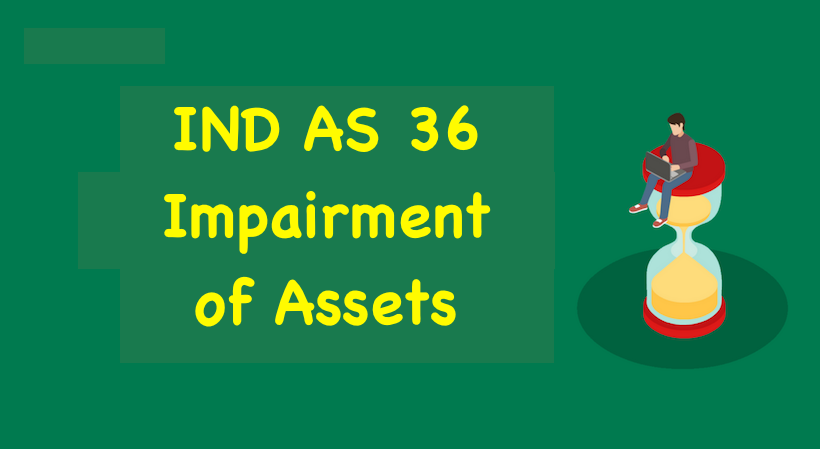IND AS 36 Impairment of Assets: The objective of Ind AS 36 is to prescribe the procedures that an entity applies to ensure that its assets are carried at no more than their recoverable amount. An asset is carried at more than its recoverable amount if its carrying amount exceeds the amount to be recovered through use or sale of the asset. If this is the case, the asset is described as impaired and the Standard requires the entity to recognise an impairment loss. The Standard also specifies when an entity should reverse an impairment loss and prescribes disclosures.
IND AS 36 Impairment of Assets
An entity shall assess at the end of each reporting period whether there is any indication that an asset may be impaired. If any such indication exists, the entity shall estimate the recoverable amount of the asset. However, irrespective of whether there is any indication of impairment, an entity shall also:
- (a) test an intangible asset with an indefinite useful life or an intangible asset not yet available for use for impairment annually by comparing its carrying amount with its recoverable amount. This impairment test may be performed at any time during an annual period, provided it is performed at the same time every year. Different intangible assets may be tested for impairment at different times. However, if such an intangible asset was initially recognised during the current annual period, that intangible asset shall be tested for impairment before the end of the current annual period.
- (b) test goodwill acquired in a business combination for impairment annually in accordance with the Standard.
If there is an indication that an asset may be impaired, recoverable amount shall be estimated for individual asset. If it is not possible to estimate the recoverable amount of the individual asset, the entity shall determine the recoverable amount of the cash generating unit to which the asset belongs (the asset’s cash generating unit).
A cash-generating unit is the smallest identifiable group of assets that generates cash inflows that are largely independent of the cash inflows from other assets or groups of assets.
Advertisement
Content in this Article
This standard shall not apply to:
- Inventories
- Contracts that are recognized in accordance with Ind AS 115
- Deferred Tax Assets
- Financial Assets
- Non-Current Assets classified for sale in accordance with Ind AS 105
- Biological Assets related to agricultural activity
- Assets arising from the employee benefits.
How to calculate impairment loss?
Impairment loss = Recoverable Value- Carrying Amount
Recoverable amount of an asset is less than its carrying amount, the carrying amount of the asset shall be reduced to its recoverable amount. That reduction is an impairment loss.
If recoverable amount is more than carrying amount of an asset, then no impairment loss will be recognized.
Recoverable amount shall be higher of the following:
- Fair Value less cost of disposal
- Value in use
Fair Value less cost of disposal
Costs of disposal are deducted while determining the fair value less cost of disposal. Examples of such costs are:
- Legal costs
- Stamp duty and similar taxes
- Costs of removing the assets
- Incremental costs for bringing the assets into the conditions for its sale
- Other costs
Value in use
It shall be calculated on the following basis:
- Estimated Future Cash Flow
- Discount Rate
Recognising and measuring an impairment loss
Paragraphs 58–108 set out the requirements for recognizing and measuring impairment losses
Paragraphs 65–108 deal with the recognition and measurement of impairment losses for cash-generating units and goodwill
An impairment loss shall be recognized immediately in Statement of profit or loss. An impairment loss on a non-revalued asset is recognized in profit or loss. However, an impairment loss on a revalued asset is recognised in other comprehensive income to the extent that the impairment loss does not exceed the amount in the revaluation surplus for that same asset. Such an impairment loss on a revalued asset reduces the revaluation surplus for that asset.
Para 62 deals with where the amount estimated for an impairment loss is greater than the carrying amount of the asset to which it relates, an entity shall recognize a liability.
When to test for Impairment?
- It can be conducted on annual basis.
Test for impairment annually when:
Intangible asset has indefinite life or intangible assets are not available for use.
- Whenever impairment indicators occurs. These are external indicators and internal indicators.
External Indicators
- Significant decline in market value
- Change in technology, market, economic or legal environment
- Change in interest rate.
- Low market capitalization
Internal Indicators
- Assets performance is declining
- Discontinuance or restructuring plan
- Evidence of physical obsolesces
Impairment loss for Cash Generating Units
Allocation of Impairment loss in the following ways:
First, to the carrying amount of any goodwill allocated to for Cash Generating Unit.
Then to other assets, pro rata on the basis of carrying amount of each asset.
Recommended Articles


Can I give exam in Dubai I am on working visa here my registration is of India
Hi sohanlal
Please contact to ICAI Regarding your Query.